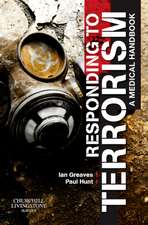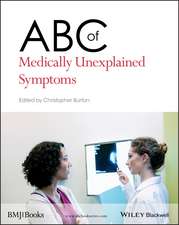Conflict and Catastrophe Medicine: A Practical Guide
Editat de James M. Ryan, Adriaan P. C. C. Hopperus Buma, Charles W. Beadling, Aroop Mozumder, David M Nott, Norman M. Rich, Walter Henny, David MacGartyen Limba Engleză Hardback – 27 ian 2014
| Toate formatele și edițiile | Preț | Express |
|---|---|---|
| Paperback (1) | 2235.67 lei 38-45 zile | |
| SPRINGER LONDON – 27 ian 2014 | 2235.67 lei 38-45 zile | |
| Hardback (1) | 2489.48 lei 6-8 săpt. | |
| SPRINGER LONDON – 27 ian 2014 | 2489.48 lei 6-8 săpt. |
Preț: 2489.48 lei
Preț vechi: 2620.51 lei
-5% Nou
Puncte Express: 3734
Preț estimativ în valută:
476.35€ • 497.35$ • 394.25£
476.35€ • 497.35$ • 394.25£
Carte tipărită la comandă
Livrare economică 04-18 aprilie
Preluare comenzi: 021 569.72.76
Specificații
ISBN-13: 9781447129264
ISBN-10: 1447129261
Pagini: 630
Ilustrații: XXXII, 964 p. 100 illus., 86 illus. in color.
Dimensiuni: 155 x 235 x 43 mm
Greutate: 17.82 kg
Ediția:3rd ed. 2014
Editura: SPRINGER LONDON
Colecția Springer
Locul publicării:London, United Kingdom
ISBN-10: 1447129261
Pagini: 630
Ilustrații: XXXII, 964 p. 100 illus., 86 illus. in color.
Dimensiuni: 155 x 235 x 43 mm
Greutate: 17.82 kg
Ediția:3rd ed. 2014
Editura: SPRINGER LONDON
Colecția Springer
Locul publicării:London, United Kingdom
Public țintă
Professional/practitionerCuprins
Section 1: The Disaster and Conflict Environment.- 1. New Paradigms: The World in the 21st Century- European Perspective.- 2. New Paradigms: The World in the 21st Century- A US Perspective.- 3. The Spectrum of Conflict.- 4. The Players- Humanitarian Organisations and their Coordination in Humanitarian Assistance.- 5. The Players- Private Military and Security Companies (PMSCs) in the Humanitarian Space.- 6. Medical Ethics in Disasters.- 7. Medicine at High Altitudes.- 8. Medical Support of Special Operations.- 9. Terrorism 101.- Section 2: Disasters, Public Health, and Populations.- 10. Disasters: An Overview.- 11. Disasters: The London Bombings, 7th July 2005: Forward Medical Response.- 12. Responding to Acute Humanitarian Crises: Health Needs Assessment and Priorities for Intervention.- 13. Responding to Acute Humanitarian Crises: The Role of Health System Levers in Response, Recovery and Rebuilding to Protect Population Health.- 14. Responding to Acute Humanitarian Crises: Health Planning in Action "Operation Phoenix": A British Medical Aid Program to Sarajevo.- 15.Responding to Acute Humanitarian Crises: Health Care of Prisoners and Detainees.- 16. Standards of Care in Catastrophic Emergencies.- 17. Program Management and Assessment.- 18. Surveillance and Control of Communicable Disease in Conflicts and Disasters.- 19. The Sword of Damocles: Whither the Next Pandemic.- Section 3: Living and Working in Austere Environments.- 20. Getting there and Being Involved: Getting Involved.- 21. Getting there and Being Involved: Team Building and Maintenance.- 22. Safety and Security: Staying Safe and Effective- In a Humanitarian Context (Or as Safe as is Reasonably Possible When You Know You Should Have Stayed at Home!).- 23. Safety and Security: Thinking Ballistic- Aspects of Protection.- 24. Safety and Security: Mines and Weapons Awareness.- 25. Safety and Security: Health Risk Management- A Tool for Planning Force Health Protection.- 26.Applied Communications for Medical Professionals in Conflict and Catastrophe Situations.- 27. Psychosocial and Mental Health Care for the Deployed Staff of Rescue, Professional First Response and Aid Agencies, NGOs and Military Organisations.- Section 4: Hospitals and Health Systems.- 28. Conflict Recovery: Health Systems in Transition.- 29. Eating an Elephant: Intervening in Hospitals- Pristina.- 30. Military Medical Contribution to Indigenous (Military and Civilian) Health Sector Development (HSD) within Security and Stabilisation Operations.- 31. Military Health Services Support in Conflict.- 32. Evacuation and Transportation.- 33. Deployed Field Hospitals in the 21st Century.- Section 5: Clinical Care.- 34. Acute Problems and Emergency Surgery: A. Introduction- Scene-Setting.- 35. Acute Problems and Emergency Surgery: Triage and Acute Care.- 36. Acute Problems and Emergency Surgery: Ballistics and Blast.- 37. Acute Problems and Emergency Surgery: Tropical Diseases.- 38. Acute Problems and Emergency Surgery: Climate: Hot and Cold- An Aide.- 39. Acute Problems and Emergency Surgery: Envenomations- Bites and Stings.- 40. Acute Problems and Emergency Surgery: Head Injury.- 41. Acute Problems and Emergency Surgery: Dental, Maxillofacial, Eye, and ENT.- 42. Acute Problems and Emergency Surgery: Abdominal Complaints and Acute Surgical Emergencies.- 43. Acute Problems and Emergency Surgery: Soft Tissues and Skeleton.- 44. Acute Problems and Emergency Surgery: Surgery in the Tropics.- 45. Acute Problems and Emergency Surgery: Anaesthesia and Analgesia.- 46. Chemical, Biological, Radiological, and Nuclear (CBRN) Casualty Management Principles.- 47. Women's Health.- 48. The Care of Children in Complex Humanitarian Emergencies and Disasters.- 49. The Psychosocial and Mental Health of People Who Are Affected by Conflict, Catastrophes, Terrorism, Adversity, and Displacement.- Section 6: Resources.- 50. Preparing to Deploy: Materials and Information.- 51. RehabilitationDiagnostic Laboratories.- 52. Enablers and Confounders: Achieving the Mission.- 53. The Military Approach to Medical Planning.- 54. Accreditation in Field Medicine.- 55. Humanitarian Work in the Era of Modernising Medical Careers.- 56. Code of Behaviour.
Recenzii
From the reviews of the third edition:
“This update is intended to be a textbook for a course preparing those who would sit for the DMCC examination … . examinees and seasoned practitioners alike can benefit from this comprehensive discussion of medical humanitarian aid in austere situations. … It does a good job of outlining the information that any worker should understand before venturing into this type of environment. … it contains valuable information for those wishing to practice medicine in tenuous, under-resourced and/or unsafe international circumstances.” (Amy Elisa Stoesz, Doody’s Book Reviews, May, 2014)
“This update is intended to be a textbook for a course preparing those who would sit for the DMCC examination … . examinees and seasoned practitioners alike can benefit from this comprehensive discussion of medical humanitarian aid in austere situations. … It does a good job of outlining the information that any worker should understand before venturing into this type of environment. … it contains valuable information for those wishing to practice medicine in tenuous, under-resourced and/or unsafe international circumstances.” (Amy Elisa Stoesz, Doody’s Book Reviews, May, 2014)
Textul de pe ultima copertă
Conflict and Catastrophe Medicine: A Practical Guide 3e follows its successful predecessors in providing a framework for use by health professionals visiting a resource-constrained environment.
Aimed at health professionals, Conflict and Catastrophe Medicine: A Practical Guide 3e encompasses problems brought about by local conflict or natural disasters. It covers preparation, organisation, logistics, treatment of major trauma and medical emergencies, and the special problems of delivering medicine in a hostile environment. This book will provide the reader with a mix of theory, opinion and practical advice to guide him through areas of conflicts, catastrophes and remote locations.
Aimed at health professionals, Conflict and Catastrophe Medicine: A Practical Guide 3e encompasses problems brought about by local conflict or natural disasters. It covers preparation, organisation, logistics, treatment of major trauma and medical emergencies, and the special problems of delivering medicine in a hostile environment. This book will provide the reader with a mix of theory, opinion and practical advice to guide him through areas of conflicts, catastrophes and remote locations.
Caracteristici
Comprehensive coverage of the topic inside one cover Practical guidance from people with accepted expertise and current field experience A practical guide for medical aid personnel working in conflicts, catastrophes and remote areas Provides background knowledge of the 'climate' in which medical aid is delivered, explains how to get involved, how to stay safe, the differences in remote medicine, and how to get home and re-adjust The emphasis given to psychosocial and physiological health needs of volunteers The mix of theory, opinion and practical advice throughout the book











